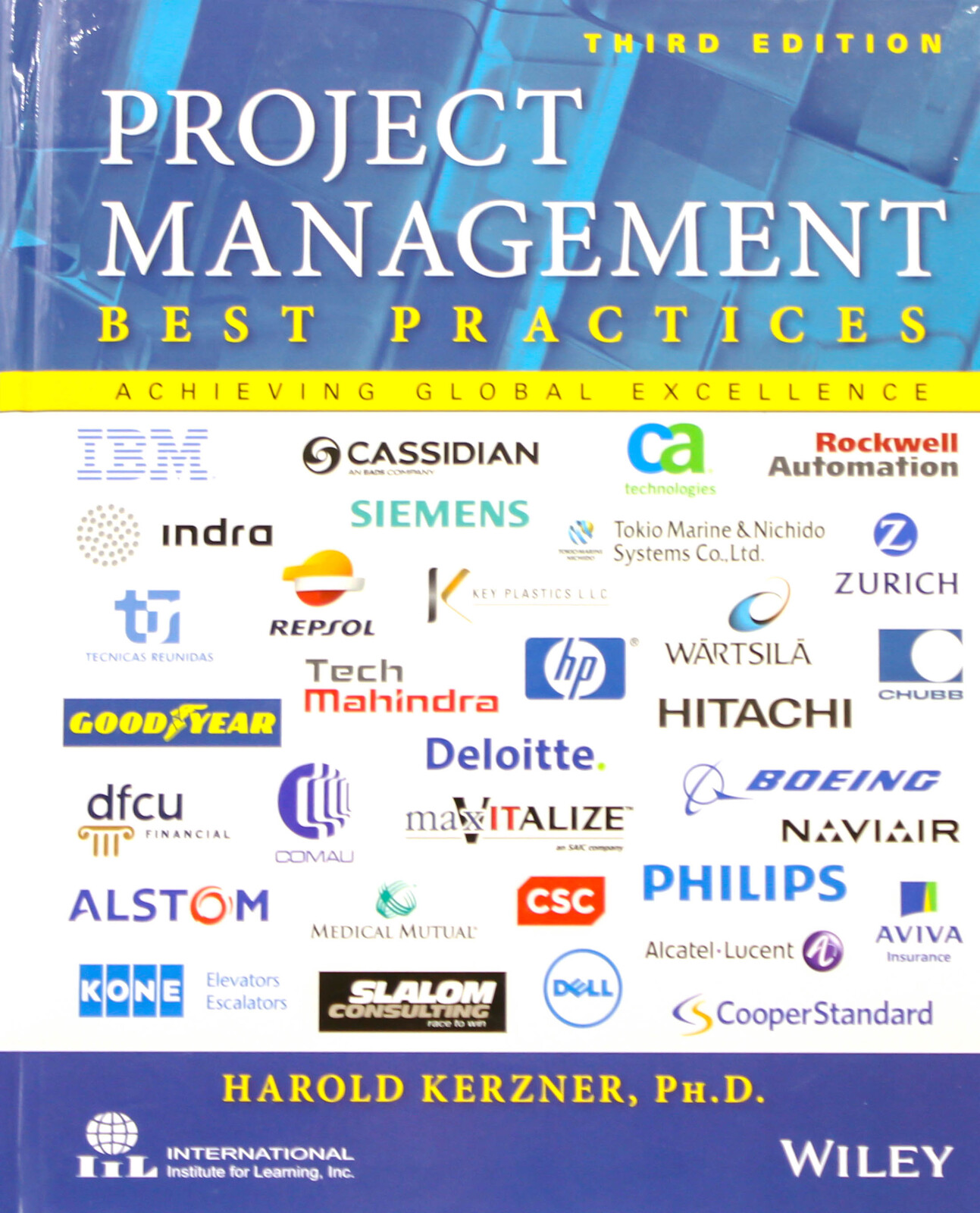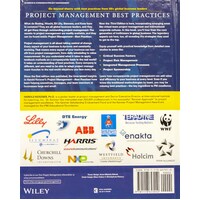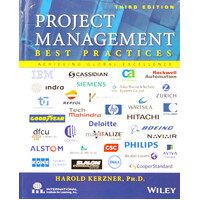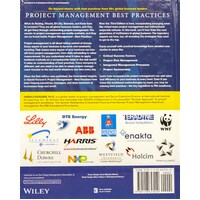Project Management - Best Practices: Achieving Global Excellence
Author: Harold R. KerznerPublisher: John Wiley & Sons IncCategory: Project Management, Engineering: GeneralAge Group: 15+Book Format: HardcoverSenior executives and project managers from more than 50 world-class companies offer their best practices for successful project management implementation The first two editions of the bestselling Project Management Best Practices helped project managers navigate the increasingly complex task of working within global corporations employing distant and diverse work teams. This new Third Edition includes the same valuable wealth of proven best practices, while following up on case studies from previous editions and offering new case studies on project management practices at large and small companies. The Third Edition offers insight from project managers and executives at more than fifty global companies in all sectors of the market. These industry-leading professionals offer insight and best practices for: Project risk management Project management for multinational cultures and cultural failures Focusing on value, as well as cost and schedule Integrated and virtual project teams Covering the latest developments in the project management field, Project Management Best Practices, Third Edition offers a must-have window into the issues and solutions facing corporate managers, project and team managers, engineers, project team members, and business consultants in today's global market.Table Of Contents
Preface xiii 1 Understanding Best Practices 1 1.0 Introduction 1 1.1 Wartsila 2 1.2 Project Management Best Practices: 1945 1960 3 1.3 Project Management Best Practices: 1960 1985 5 1.4 Project Management Best Practices: 1985 2014 8 1.5 An Executive s View of Project Management 13 1.6 Best Practices Process 17 1.7 Step 1: Definition of a Best Practice 18 1.8 Step 2: Seeking Out Best Practices 22 1.9 Dashboards and Scorecards 33 1.10 Key Performance Indicators 36 1.11 Step 3: Validating the Best Practice 41 1.12 Step 4: Levels of Best Practices 44 1.13 Step 5: Management of Best Practices 46 1.14 Step 6: Revalidating Best Practices 46 1.15 Step 7: What to Do with a Best Practice 47 1.16 Step 8: Communicating Best Practices across the Company 48 1.17 Step 9: Ensuring Usage of the Best Practices 51 1.18 Common Beliefs 51 1.19 Best Practices Library 52 1.20 Hewlett-Packard: Best Practices in Action 54 1.21 DTE Energy 57 1.22 A Consultant s View of Project Management and Best Practices 61 2 From Best Practice to Migraine Headache 67 2.0 Introduction 67 2.1 Good Intentions Becoming Migraines 67 2.2 Enterprise Project Management Methodology Migraine 69 2.3 Customer Satisfaction Migraine 69 2.4 Migraine Resulting from Responding to Changing Customer Requirements 70 2.5 Reporting Level of the PMO Migraine 71 2.6 Cash Flow Dilemma Migraine 71 2.7 Scope Change Dilemma Migraine 72 2.8 Outsource or Not Migraine 73 2.9 Determining When to Cancel a Project Migraine 73 2.10 Providing Project Awards Migraine 74 2.11 Migraine from Having the Wrong Culture in Place 75 2.12 Migraines due to Politics 76 2.13 Migraines Caused by the Seven Deadly Sins 83 2.14 Sources of Smaller Migraines 94 2.15 Ten Uglies of Projects 97 References 105 3 Journey to Excellence 107 3.0 Introduction 107 3.1 Strategic Planning for Project Management 109 3.2 Hitachi Ltd. 118 3.3 KONE: The Project Management Challenge 130 3.4 The Light at the End of the Tunnel 133 3.5 Goodyear 136 3.6 Managing Assumptions 140 3.7 Managing Assumptions in Conservation Projects WWF International 140 3.8 Project Governance 142 3.9 Seven Fallacies That Delay Project Management Maturity 146 3.10 Motorola 148 3.11 Texas Instruments 149 3.12 Hewlett-Packard: Recognizing the Need 152 3.13 Hewlett-Packard: The Journey and the Obstacles 153 3.14 CooperStandard 160 3.15 Naviair: On Time on Budget 166 3.16 DTE Energy 175 3.17 Key Plastics 176 3.18 ILLUMINAT and the Strategic Business of Project Management 179 3.19 Avalon Power and Light 183 3.20 Roadway Express 184 3.21 Defcon Corporation 185 3.22 Kombs Engineering 187 3.23 Williams Machine Tool Company 188 4 Project Management Methodologies 191 4.0 Introduction 191 4.1 Excellence Defined 192 4.2 Recognizing the Need for Methodology Development 196 4.3 Enterprise Project Management Methodologies 199 4.4 Benefits of a Standard Methodology 204 4.5 Critical Components 205 4.6 SAP 207 4.7 Cassidian: Integrated Multilevel Schedules 211 4.8 Tecnicas Reunidas 213 4.9 Teradyne: From Myth to Reality 220 4.10 Slalom Consulting: Project Management Functions 224 4.11 Slalom Consulting: Replacing Methodologies with Frameworks 226 4.12 Life-Cycle Phases 228 4.13 Expanding Life-Cycle Phases 230 4.14 Churchill Downs, Incorporated 230 4.15 Indra: The Need for a Methodology 232 4.16 Implementing the Methodology 233 4.17 Implementation Blunders 235 4.18 Overcoming Development and Implementation Barriers 235 4.19 Project Management Tools 236 4.20 Wartsila: Recognizing the Need for Supporting Tools 242 4.21 Tech Mahindra Limited: Project Process Monitoring 244 4.22 Tech Mahindra Limited: Customer Delight Index for Projects 247 4.23 General Motors Powertrain Group 251 4.24 Ericsson Telecom AB 252 4.25 Indra: Closing the Project 255 4.26 Repsol: The Repsol E&P GIP (c) Methodology The Project Quality Management Process Applied to Decision Making 258 4.27 Rockwell Automation: Quest for a Common Process 266 4.28 Sherwin-Williams 271 4.29 Medical Mutual 275 4.30 Holcim 278 4.31 Westfield Group 281 4.32 Hewlett-Packard 284 4.33 DTE Energy 286 4.34 ALSTOM 293 4.35 Cassidian: Golden Rules in Project Management 297 4.36 When Traditional Methodologies May Not Work 299 5 Integrated Processes 303 5.0 Introduction 303 5.1 Understanding Integrated Management Processes 304 5.2 Evolution of Complementary Project Management Processes 305 5.3 Zurich America Insurance Company 309 5.4 Total Quality Management 310 5.5 Concurrent Engineering 315 5.6 Risk Management 315 5.7 Wartsila: The Need for Proactive Risk Management 318 5.8 ILLUMINAT: Effective Risk Management 321 5.9 Indra: When a Risk Becomes Reality (Issue Management) 325 5.10 The Failure of Risk Management 327 5.11 Defining Maturity Using Risk Management 328 5.12 Boeing Aircraft Company 329 5.13 Change Management 330 5.14 Other Management Processes 331 5.15 Hewlett-Packard 331 5.16 Earned-Value Measurement 333 5.17 DTE Energy 333 6 Culture 335 6.0 Introduction 335 6.1 Creation of a Corporate Culture 336 6.2 Corporate Values 338 6.3 Types of Cultures 338 6.4 Corporate Cultures at Work 340 6.5 Indra: Building a Cohesive Culture 343 6.6 maxIT-VCS 346 6.7 DFCU Financial 348 6.8 Illuminat (Trinidad & Tobago) Limited 363 6.9 DTE Energy 365 6.10 Hewlett-Packard 366 6.11 Barriers to Implementing Project Management in Emerging Markets 367 7 Management Support 375 7.0 Introduction 375 7.1 Visible Support from Senior Managers 375 7.2 Project Sponsorship 376 7.3 Excellence in Project Sponsorship 380 7.4 Hewlett-Packard Sponsorship in Action 381 7.5 Zurich America Insurance Company: Improving Stakeholder Engagement 382 7.6 Project Governance 383 7.7 Tokio Marine: Excellence in Project Governance 385 7.8 Empowerment of Project Managers 391 7.9 Management Support at Work 392 7.10 Getting Line Management Support 395 7.11 DTE Energy 396 7.12 Initiation Champions and Exit Champions 397 8 Training and Education 401 8.0 Introduction 401 8.1 Training for Modern Project Management 401 8.2 Need for Business Education 403 8.3 SAP: Importance of a Project Management Career Path 404 8.4 International Institute for Learning 406 8.5 Identifying the Need for Training 410 8.6 Selecting Students 411 8.7 Fundamentals of Project Management Education 411 8.8 Some Changes in Project Management Education 412 8.9 Designing Courses and Conducting Training 414 8.10 Measuring the Return on Investment on Education 416 8.11 Project Management Is Now a Profession 416 8.12 Competency Models 419 8.13 Harris Corporation 429 8.14 Alcatel-Lucent: Recognizing the Value of a PMP 434 8.15 Integrated Project Management at Tech Mahindra Limited 436 8.16 Hewlett-Packard 439 9 Informal Project Management 441 9.0 Introduction 441 9.1 Informal versus Formal Project Management 441 9.2 Trust 444 9.3 Communication 445 9.4 Cooperation 447 9.5 Teamwork 447 9.6 Color-Coded Status Reporting 448 9.7 Crisis Dashboards 449 9.8 Informal Project Management at Work 452 10 Behavioral Excellence 455 10.0 Introduction 455 10.1 Situational Leadership 455 10.2 Conflict Resolution 458 10.3 Staffing for Excellence 460 10.4 Virtual Project Teams 462 10.5 Rewarding Project Teams 464 10.6 Keys to Behavioral Excellence 467 10.7 Proactive versus Reactive Management 470 11 Measuring Return on Investment on Project Management Training Dollars 475 11.0 Introduction 475 11.1 Project Management Benefits 476 11.2 Growth of ROI Modeling 477 11.3 The ROI Model 478 11.4 Planning Life-Cycle Phase 479 11.5 Data Collection Life-Cycle Phase 480 11.6 Data Analysis Life-Cycle Phase 483 11.7 Reporting Life-Cycle Phase 487 11.8 Conclusions 487 12 The Project Office 489 12.0 Introduction 489 12.1 Boeing 492 12.2 Philips Healthcare Software Customer Services 493 12.3 maxIT-VCS 500 12.4 Aviva 502 12.5 Churchill Downs Incorporated (CDI): Establishing a PMO 517 12.6 Churchill Downs Incorporated (CDI): Managing Scope Changes 518 12.7 Types of Project Offices 522 12.8 Dell Inc. 523 12.9 Computer Sciences Corporation (CSC) 532 12.10 Slalom Consulting: Understanding the Nature of a PMO 538 12.11 DTE Energy 546 12.12 Chubb 547 12.13 Hewlett-Packard 548 12.14 Star Alliance 550 12.15 Project Audits and the PMO 552 12.16 Project Health Checks 555 12.17 PMO of the Year Award 557 13 Six Sigma and the Project Management Office 565 13.0 Introduction 565 13.1 Project Management Six Sigma Relationship 565 13.2 Involving the PMO 568 13.3 Traditional versus Nontraditional Six Sigma 568 13.4 Understanding Six Sigma 571 13.5 Six Sigma Myths 573 13.6 Use of Assessments 575 13.7 Project Selection 577 13.8 Typical PMO Six Sigma Projects 579 14 Project Portfolio Management 581 14.0 Introduction 581 14.1 Why Use Portfolio Management? 582 14.2 Involvement of Senior Management, Stakeholders, and the PMO 583 14.3 Project Selection Obstacles 588 14.4 Identification of Projects 588 14.5 Preliminary Evaluation 592 14.6 Strategic Selection of Projects 593 14.7 Strategic Timing 596 14.8 Analyzing the Portfolio 596 14.9 Problems with Meeting Expectations 599 14.10 Portfolio Management at Rockwell Automation 601 14.11 World Wildlife Fund (WWF) 602 15 Global Project Management Excellence 607 15.0 Introduction 607 15.1 IBM 608 15.2 Computer Associates Technologies (CA): Successful Project Delivery and Management 634 15.3 Microsoft Corporation 647 15.4 Deloitte: Enterprise Program Management 659 15.5 COMAU 680 15.6 Fluor Corporation: Knowledge Management for Project Execution 692 15.7 Siemens PLM Software: Developing a Global Project Management Methodology 705 16 Value-Driven Project Management 713 16.0 Introduction 713 16.1 Value over the Years 714 16.2 Values and Leadership 717 17 Effect of Mergers and Acquisitions on Project Management 731 17.0 Introduction 731 17.1 Planning for Growth 731 17.2 Project Management Value-Added Chain 732 17.3 Preacquisition Decision Making 735 17.4 Landlords and Tenants 740 17.5 Best Practices: Case Study on Johnson Controls, Inc. 741 17.6 Integration Results 745 17.7 Value Chain Strategies 747 17.8 Failure and Restructuring 749 Index 751About Harold Kerzner
HAROLD KERZNER, Ph. D. is a global leader in project management and Senior Executive Director at International Institute for Learning, Inc. Dr. Kerzner has instructed over 200,000 professionals in his successful Kerzner Approach to project management excellence. The Kerzner Scholarship Endowment Fund and the Kerzner Project Management Award are managed by the PMI Educational Foundation.| SKU | BK-9781118657010 |
| Barcode # | 9781118657010 |
| Brand | John Wiley & Sons Inc |
| Artist / Author | Harold R. Kerzner |
| Shipping Weight | 1.2500kg |
| Shipping Width | 0.200m |
| Shipping Height | 0.030m |
| Shipping Length | 0.250m |
| Assembled Length | 20.000m |
| Assembled Height | 25.000m |
| Assembled Width | 3.000m |
| Type | Hardcover |






